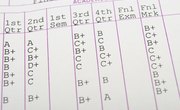Understanding how to curve grades fairly can be confusing. A grading scheme is chosen for a wide variety of reasons by the professor. There are pros and cons regarding curved grading. A good grading system allows the professor to understand how to curve a grade distribution and therefore assist all students in the class to strive to be their best.
How a Grading Curve Is Put in Place
Instructors can select a method on how to curve grades in BlackBoard or another system that echoes the same one that they were assessed with when they were students. Some may choose to try a new method that was suggested to them by a senior faculty member or college mentor.
How to curve a test is typically based on the type of class, range of students and number of instructors that need to interact with the class in order to fully explain the complicated material.
Some critics of the curve system believe it doesn’t help as much as it hurts, while others depend on a curved grading system to ensure that all students are judged fairly on their grasp of the material. Not all schools or teachers use a grading curve.
How to Curve a Test
Grade curving is defined by the distribution of the scores of all the pupils in the class. The grades are determined after all of the pupils' scores for the assignment or the test are dispensed. If the top or bottom performing student exit the program or drop the class, the curve naturally adjusts.
Curving, which can also be called norm-referenced grading, assigns grades to pupils based on their individual performance in regards to the entire group of students.
Norm-referenced grading provides a good way to standardize the course tests. When there are multiple instructors that teach a course, such as a lab class, the curve grading system allows students to be graded fairly based on the overall instruction.
Benefits of a Grading System
Overall, teachers and educators work under the assumption that creating competition creates academic motivation for students and can generally enhance their sense of self-worth. A grading system is intended to judge a student’s individual grasp of the material that the class covered as well as create a chart for success.
A well-crafted curving grade system can ease the stress that students feel about getting all “A” grades. The right curve grading system is fair to all of the students so that all have a chance to get the most out of the class and pass.
Disadvantages of Grade Curving
The curved grading system makes the entire class compete against each other to be at the top of the curve and therefore obtain the best grades.
No matter how well designed the grading system is, the curving can make some students feel they are being short-changed. Students who are doing well but are at the bottom of the class may complain that the system is not fair to them.
Critics of the curved grading system argue that in order for a student to succeed in the class, they need a counterpart that will not fair well. This doesn’t reflect what the student at the bottom of the curve truly learned or their grasp of the course material.
Criterion-Referenced Grading
This is the traditional way that teachers grade their classes. When grades from assignments or tests are not curved, the instructor determines the cut off for grades. This is typically done at the beginning of the semester or term. The class understands what the threshold is for an A.
The criterion-referenced grading set by the instructor can vary. Generally, non-curved grade thresholds are as follows:
- 90-100 = A
- 79-89 = B
- 69-78 = C
- 59-68 = D
- 58 and below is a failing grade, or F
Within those parameters are further gradations. For instance, anything toward the low end of the value is considered a minus while anything toward the top of the value is positive. A 92 would be an A- , while a 98 would be considered an A+, although that would depend on the teacher’s grading system.
Why Choose a Grading System?
The difference between a curved grading or criterion-referenced grading system is significant.
A criterion-referenced grading system allows the students to compete against themselves to get the best grade they can. With this type of grading system, they know what their grade will be based on the answers they know they did well on in assignments and tests.
The teacher may decide to have the A category stop short at 92 points or make other parameters that require the student to work harder to achieve good grades in the class. This type of grading system is based on the individual and not the group’s overall success or failure.
A curved grading system offers the instructor a way to standardize the class’s grades. This works well when it is a large class with more than one instructor responsible for the course over a long period. The curve for grading ensures that the distribution of grades is comparable year after year and allows supervisors to know the class is gaining the information it needs.
Other Types of Grade Curving Systems
The grading system that the instructor chooses will determine how to curve a test or overall grade for the class.
- The Bell Curve: Probably the most well-known, the bell curve uses a statistical technique to reshape the distribution and normalize scores. This statistical system creates a bell shape when plotted out on paper. The instructor begins by assigning a grate to the middle score, which is typically C+. They then determine grade brinks based on the distance of scores from this main median reference point. Often these are done on a spreadsheet to normalize the scores efficiently.
- Quota Systems: This type of grading curve is typically applied to law schools. The professor predetermines the number of students who will be able to earn each level of grade. They then apply these quotas after rank ordering the student scores.
- Clumping: The teacher creates a dispersal of the scores and identifies clusters of student scores. These are separated by breaks in the distribution. The instructor then uses these gaps as a way to assign individual grades.
Sample Curve for Students
If you are curious about your grade before it is assessed by the instructor, you can calculate your approximate score if you know a few important variables.
- The total number of questions on the test
- The total number of questions that the top student believes they answered correctly
- The total number of questions you believe you answered correctly
To arrive at the estimated curved grade, calculate the differences between the total number of questions on the exam by the amount of correctly answered questions the top student believes she completed. For instance, if the test had a total of 25 questions and the top student is sure he answered at least 20 correct, then the difference is five points.
To figure out your score, add the difference to your original score. If you had an 18, your score would end up to be 23, putting you into a solid “A” grade. Students with scores of 15 will have a score of 20 and those with 10 will have a 15.
Related Articles
References
Writer Bio
Kimberley McGee is an award-winning journalist with 20+ years of experience writing about education, jobs, business trends and more for The New York Times, Las Vegas Review-Journal, Today’s Parent and other publications. She graduated with a B.A. in Journalism from UNLV. Her full bio and clips can be seen at www.vegaswriter.com.










